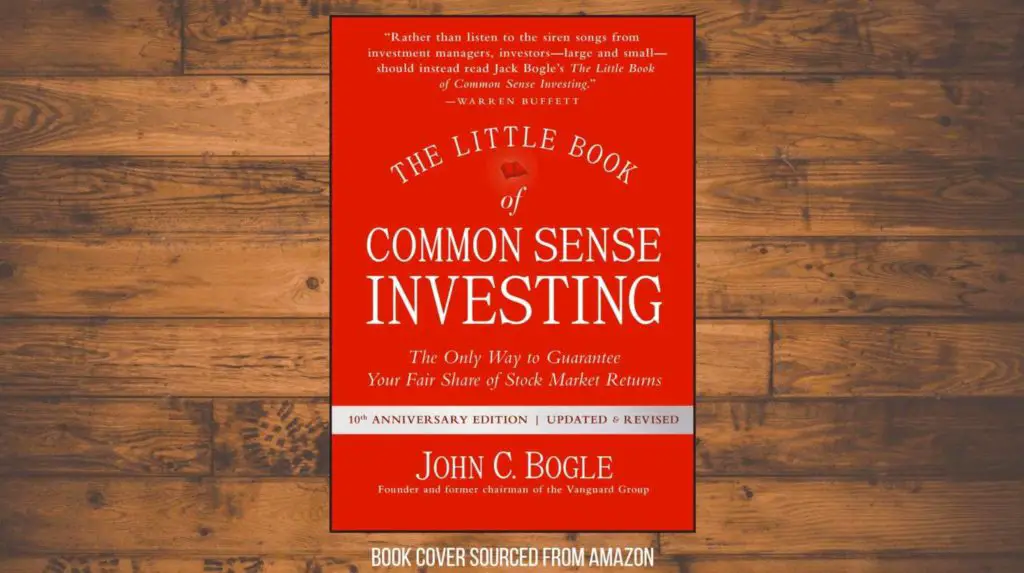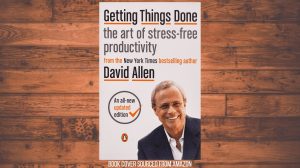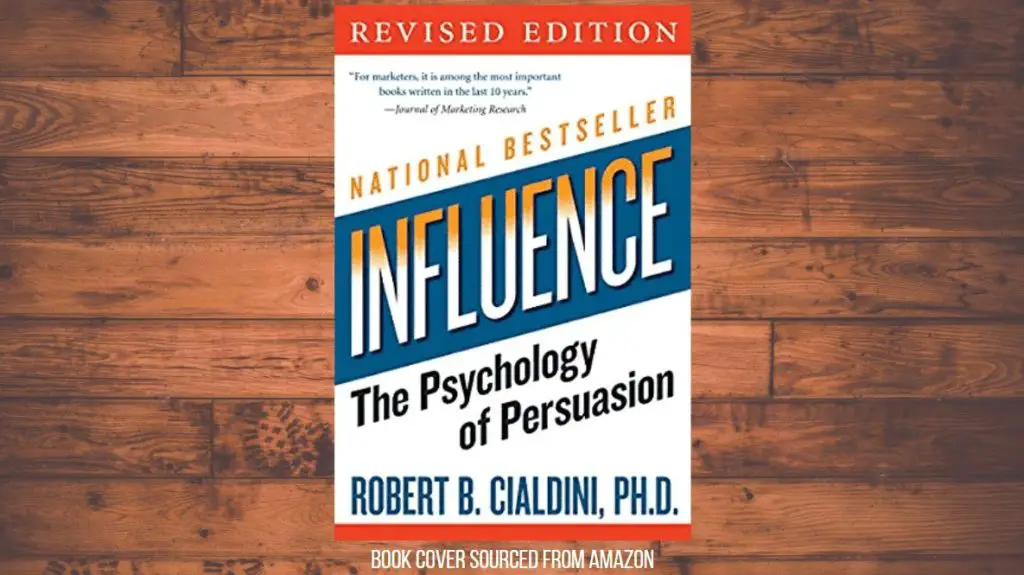This post may contain affiliate links, which means I’ll receive a commission if you purchase through my links, at no extra cost to you. Please read full disclosure for more information.
ABOUT
- Title: The Little Book of Common Sense Investing
- Sub-title: The Only Way to Guarantee Your Fair Share of Stock Market Returns
- Author: John C. Bogle
- About the author: John C. Bogle is a legend that founded The Vanguard Group and is credited with creating the first index fund in the 1970s. His career includes a laundry list of achievements and recognition.
- Pages: 304
- Published: 2017
- Link to book
HIGH-LEVEL SUMMARY
The Little Book of Common Sense Investing is authored by the legendary John C. Bogle. He is a successful investor, businessman, and philanthropist that founded The Vanguard Group. Bogle is also the father of the index fund.
He wrote this book with hopes to change the way you think about investing. Throughout the chapters, he will walk you through how financial markets work and show you why the index fund is the best investment option to guarantee you get your fair share of market returns.
While all the claims in the book lead back to the mighty index fund, the book will teach you much more.
Topics covered in the book include
- Shareholders gains vs business gains
- How you can win by keeping it simple
- The large impact of fees
- Why you can’t trust past performance and 5-star fund ratings
- Tax efficiency
- Rules of humble arithmetic
- Advice on selecting funds
- Why the future will have subdued returns
- Tips for retirement investing
- The importance of asset allocation and how to do it
You’ll find a common theme in the book of simplicity and basic math. Author John Bogle wants you to disregard the unnecessary complexities of the financial services industry. When you understand the math, you’ll have clarity on the path you should take.
RECOMMENDATION
The Little Book of Common Sense Investing strips away the complexity from investing. Because of that, I would recommend this book to anyone.
For beginners, this book is an excellent guide to learn how to invest efficiently and safely. For “experienced” investors, this book can be valuable to refer back to the basic fundamentals.
If you are looking for a way to maximize your long-term returns while minimizing hassle and fees, this book will teach you how.
Check out these related posts next!
- Mutual Funds vs Index Funds
- Book Review: The Path by Peter Mallouk and Tony Robbins
- Book Review: The Psychology of Money by Morgan Housel
- Book Review: I Will Teach You To Be Rich by Ramit Sethi
- Book Review: Financial Freedom by Grant Sabatier
TOP 20 TAKEAWAYS
- In no particular order
1. Successful investing is all about common sense.
2. The way to wealth is not only to capitalize on the magic of long-term compounding of returns, but to avoid the tyranny of long-term compounding of costs.
3. Simple math and history show that the winning strategy for investing in stocks is to own all of the nation’s publicly held businesses at a very low cost. The best way to implement this strategy is to buy an index fund.
4. The index fund is simply a basket (portfolio) that holds many, many (stocks) designed to mimic the overall performance of the U.S. stock market (or any financial market or market sector). Index funds operate with minimal expenses and with no advisory fees, with tiny portfolio turnover, and with high tax efficiency.
5. When you understand how our financial markets actually work, you will see that the index fund is indeed the only investment that essentially guarantees that you will capture your fair share of the returns that business earns.
6. Accurately forecasting short-term swings in investor emotions is not possible. But forecasting the long-term economics of investing has carried remarkably high odds of success.
7. Before costs, beating the market is a zero-sum game. After costs, it is a loser’s game. Typical costs in mutual funds include management fees, operating expenses, and costs from turnover. All in costs of equity fund ownership can be as much as 2% to 3% per year.
8. Our financial system has created enormous fortunes for those who manage other people’s money. If the managers take nothing, the investors receive everything: the market’s return.
9. Expense ratios can help you make better decisions with choosing a mutual fund. In every single time period and data point tested, low-cost funds beat high-cost funds.
10. Since 1926, dividends have contributed an average annual return of 4.2 percent, accounting for fully 42 percent of the stock market’s annual return of 10.0 percent for the period.
11. Managed mutual funds are astonishingly tax-inefficient. The portfolio turnover of the average actively managed equity fund, including both purchases and sales, now comes to 78 percent per year. The traditional index fund follows precisely the opposite policy—buying and holding “forever.” Its annual portfolio turnover has run in the range of 3 percent.
12. Fund returns are devastated by costs, adverse fund selections, bad timing, taxes, and inflation.
13. Both common sense and humble arithmetic tell us that we’re facing an era of subdued returns in the stock market. In the era of subdued stock and bond market returns that most likely lies in prospect, fund costs will become more important than ever
14. Easy as it is to identify past (mutual fund) winners, there is little evidence that such performance persists in the future. Trying to select a mutual fund that will outpace the stock market over the long term is like “looking for a needle in the haystack.”
15. Fund performance reverts toward the mean, or even below. Reversion to the mean (RTM)—the tendency of funds whose records substantially exceed industry norms to return toward the average or below—is alive and well in the mutual fund industry.
16. There is simply no evidence that the fund selection advice RIAs and brokers provide has produced any better returns than those achieved by fund investors on average.
17. All index funds are not created equal. Costs to investors vary widely. Although their index-based portfolios are substantially identical, their costs are anything but identical.
18. Investors should hold a bond fund because it can help in short runs, reduce volatility in your portfolio, and bond yields still exceed dividend yields. Invest in a total bond market index fund. Bond funds also have broad diversification, rock-bottom costs, disciplined portfolio activity, tax efficiency, and focus on shareholders who place their trust in long-term strategies.
19. There is nothing wrong with investing in indexed ETFs (Exchange-Traded Funds) that track the broad stock market as long as you don’t trade them. ETFs are a dream come true for entrepreneurs and brokers, but they may not be an investor’s dream come true if they aren’t used wisely.
20. Ninety-four percent of the differences in portfolio returns is explained by asset allocation. Benjamin Graham believed that your first investment decision should be how to allocate your investment assets.
WHAT I LIKED

Repetitive in a good way
This book repeats statements throughout the book. Paraphrased examples include:
- “Index funds are the best option for investing”
- “No mutual funds can consistently outperform over the long-term”
- “Beware of fees”
I say that the book is repetitive in a good way because these ideas should be engrained in the reader’s brain once they finish the book. These are fundamental truths that every investor should follow, yet most don’t.
Claims proven with basic math and statistics
John Bogle touts how simple arithmetic shows x, y, and z throughout the book. He will make claims and then back them up with the math and stats. Nothing is too advanced which allows the reader to understand. Results of calculations, research, and studies may surprise you or seem counterintuitive, but are irrefutable nonetheless.
Quotes and opinions from respected professionals
The end of each chapter has a section titled “Don’t Take My Word For It.” These sections each contain a few quotes and opinions from other respected and qualified individuals in the investing and finance world. Examples include Charles Munger, Burton Malkiel, Benjamin Graham, David Swenson, Peter Lynch, Warren Buffet, and more.
The excerpts from the individuals will support the case that the chapter tried to make. For example, Chapter Five discusses fund fees and how the more fund managers take in fees, the less investors make. The “Don’t Take My Word For It” at the end of the chapter talks about one of the first journalists to recognize the important role of mutual fund costs.
I really liked these sections because they are essentially social proof for the statements made in the book.
BENEFITS TO YOUR LIFE AND CAREER

Remove headache and hassle of investing
Following the advice in The Little Book of Common Sense Investing will remove the headache and hassle of investing.
You will spend less time researching and worrying about the process from beginning to end. During the highs and lows of the market, you won’t feel the rollercoaster of emotions that other investors that “play” the market will feel.
The financial services industry is filled with complicated jargon and financial products. The book demonstrates that easy and simple does the trick.
Achieve returns better than the majority
In addition to bypassing stress and wasted time, you will achieve better returns than the majority of investors out there. All you have to do is stay on the path and consistently save and invest.
Start early to let compounding do its work. Minimize fees and stay invested in the market, specifically in index funds. Over the long run, you will win.
Retire comfortably
The two benefits above will lead to this benefit here: you retiring comfortably.
By retirement, you will have been in the market for decades doing the simple yet effective things year after year. Knowing that this is your future can be reassuring.
Many folks in their 40s and 50s worry about not having enough to retire on. You will have peace of mind knowing that you are on the right track.
10 ACTIONS YOU SHOULD TAKE
1. Start to invest at the earliest possible moment and put money away from then on.
2. Buy a low-cost index fund and hold it forever.
3. When selecting an index fund, understand that not all index funds are the same. Look at the fees and find a reputable fund with the lowest fees.
4. Invest in bond market index funds and international index funds as well.
5. Resist the urge to be active and always needing to trade something.
6. Keep your emotions out of investing. Purchasing total market index funds and bond index funds will eliminate the effect of emotions.
7. Don’t select mutual funds based on recent performance or star rating. The research shows they won’t be able to maintain the performance. Just go with the index fund.
8. If you hire a Registered Investment Adviser (RIA) make sure they abide by the fiduciary standard and work as fee-only advisers.
9. Do not trade ETFs or you will defeat the purpose of it. Like index funds, they should be bought once and held forever.
10. Learn about asset allocation and identify an appropriate asset allocation plan for yourself. With 94% of differences in portfolio returns due to asset allocation, this should not be taken lightly.
RESOURCES
The Little Book of Common Sense Investing can be found on Amazon at this link here if you are interested in reading.



